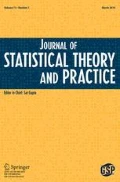Abstract
Most statistical inferences, which are essential for decision making and research in the area of biomedical sciences, are valid only under certain assumptions. One of the important assumptions in the literature is the symmetry of the underlying distribution of a study population. Several tests of symmetry are found in the literature. Most of these tests suffer from low statistical power which fails to detect a small but meaningful asymmetry in the population. Many investigators have attempted to improve the power of some of these tests. This paper examines several ranked set sample designs for the runs test of symmetry. Our investigation reveals that an optimal ranked set sample design for runs test of symmetry is the extreme ranked set sample (extreme ordered statistics sampling) (ERSS). This design of sampling increases the power and improves the performance of the runs test of symmetry and hence reduces the sample size needed in the study and the cost of the study. Intensive simulation is conducted to examine the power of the proposed optimal design for small sample sizes. Finally, base deficit values for patients subject to either blunt trauma or penetrating trauma are used to illustrate the procedures developed in this paper.
Similar content being viewed by others
References
Baklizi A., 2003. A conditional distribution free runs test for symmetry. Nonparametric Statistics, 15, 713–718.
Bohn, L.L., Wolfe, D.A., 1992. Nonparametric two-sample procedures for ranked-set samples data. Journal of American Statistical Association, 87, 522–561.
Bohn, L.L., Wolfe, D.A., 1994. The effect of imperfect judgment on ranked-set samples analog of the Mann-Whitney-Wilcoxon statistics. Journal of American Statistical Association, 89, 168–176.
Butler, C.C., 1969. A test for symmetry using sample distribution function. The Annals of Mathematical Statistics, 40, 2211–2214.
Chen, Z., 2001. Optimal ranked-set sampling scheme for inference on population quantiles. Statistica Sinica, 11, 23–37.
Davis, J.W., Mackersie, R.C., Holbrook, T.L., Hoyt, D.B., 1991. Base deficit as an indicator of significant abdominal injury. Annals Emerging Medicine, 20, 1406–1407.
Davis J.W., Shackford, S.R., Mackersie, R.C., Hoyt, D.B., 1988. Base deficit as a guide to volume Resuscitation. Journal of Trauma, 28, 1464–1467.
Dell, T.R., Clutter, J.L., 1972. Ranked set sampling theory with order statistics background. Biometrics, 28, 545–555.
Halls, L.K., Dell, T.R., 1966. Trial of ranked set sampling for forage yields. Forest Science, 12, 22–26.
Hettmansperger, T.P., 1984. Statistical Inference Based on Ranks. John Wiley & Sons, Inc.
Hettmansperger, T.P., 1995. The ranked-set sample sign test. Journal of Nonparametric Statistics, 4, 263–270
Hill, D.L., Rao, P.V., 1977. Test of Symmetry based on Cramer-Von Mises statistics. Biometrika, 64, 489–494.
Kaur, A., Patil, G. P., and Taillie, C., 2000. Optimal allocation for symmetric distributions in ranked set sampling. Annals of the Institute of Statistical Mathematics, 52, 239–254.
Kaur, A., Patil, G.P., Sinha A.K., Taillie, C., 1995. Ranked set sampling: An annotated bibliography. Environmental Ecological Statistics, 2, 25–54.
Koti, K.M., Babu, G.J., 1996. Sign test for ranked-set sampling. Communication in Statistics Theory and Methods, 25, 1617–1630.
Kvam, P.H., Samaniego, F.J., 1994. Nonparametric maximum likelihood estimation based on ranked set samples. Journal of American Statistical Association, 89, 526–537.
McIntyre, G.A., 1952. A method for unbiased selective sampling, using ranked sets. Australian Journal of Agriculture Research, 3, 385–90.
McWilliams, T.P., 1990. A distribution-free test of symmetry based on a runs statistic. Journal of American Statistical Association, 85, 1130–1133.
Modarres R., Gastwirth J.L., 1996. A modified runs test of symmetry. Statistics & Probability Letters, 31, 107–112.
Muttlak, H.A., 1997. Median ranked set sampling. Journal of applied Statistical Sciences, 6, 245–255.
Öztürk, O., 1999. One and two sample sign tests for ranked set samples with selective designs. Communication in Statistics, Theory and Methods, 28, 1231–1245.
Öztürk, O., Wolfe, D.A., 2000. Alternative ranked set sampling protocols for the sign test. Statistics & Probability Letters, 47, 15–23.
Öztürk, O., 2001. A nonparametric test of symmetry versus asymmetry for ranked-set samples. Communication in Statistics, Theory and Methods, 30, 2117–2133.
Patil, G.P., Sinha, A.K., Tillie C., 1999. Ranked set sampling: a bibliography. Environmental Ecological Statistics, 6, 91–98.
Ramberg, J.S., Schmeiser, B.W., 1974. An approximate method for generating asymmetric random variables. Communications of the ACM, 17, 78–82.
Rothman, E.D., Woodroofe, M.A, 1972. Cramer-Von Mises type statistic for testing symmetry. The Annals of Mathematical Statistics, 43, 2035–2038.
Samawi, H.M., 2001. On quantiles estimation using ranked samples with some applications. Journal of Korean Statistical Association, 30, 667–678.
Samawi H.M. and Al-Saleh F.M. (2004). On bivariate ranked set sampling for distribution and quantile estimation and quantile interval estimation using ratio estimator. Communication in Statistics, Theory and Methods, 33, 1801–1819.
Samawi, H.M., Ahmed, M.S. and Abu-Dayyeh, W., 1996. Estimating the population mean using extreme ranked set sampling. Biometrical Journal, 38, 577–586.
Samawi, H.M., Abu-Dayyeh, W. (2003). More powerful sign test using median ranked set sample: Finite sample power comparison. Communication in Statistics, Computation and Simulation, 73, 697–708.
Tajuddin, I.H., 1994. Distribution-Free test for symmetry based on Wilcoxon two-sample test. Journal Applied Statistics, 21, 409–415.
Sinha, Arun K., 2005. On some recent developments in ranked set sampling. Bulletin of Informatics and Cybernetics, 37, 137–160.
Takahasi, K., Wakimoto, K., 1968. On unbiased estimates of the population mean based on the stratified sampling by means of ordering. Annals of the Institute of Statistical Mathematics, 20, 1–31.
Tremblay, L.N., Feliciano, D.V., Rozycki, G.S., 2002. Assessment of initial base deficit as a predictor of outcome: mechanism does make a difference. American Surgeon, 68, 689–694.
Author information
Authors and Affiliations
Corresponding author
Rights and permissions
About this article
Cite this article
Samawi, H.M., Vogel, R. & Senkowski, C.K. On Distribution-Free Runs Test for Symmetry using Extreme Ranked Set Sampling with an Application Involving Base Deficit Score. J Stat Theory Pract 4, 289–301 (2010). https://doi.org/10.1080/15598608.2010.10411987
Received:
Revised:
Published:
Issue Date:
DOI: https://doi.org/10.1080/15598608.2010.10411987



